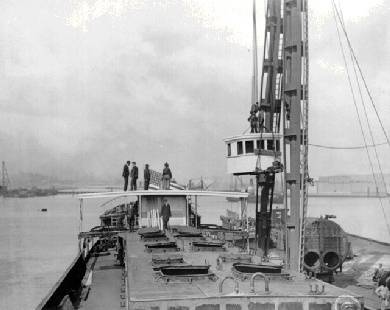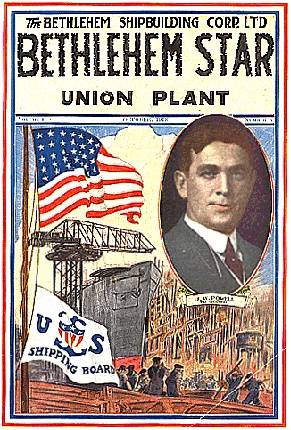Union Iron Works at Potrero Hill: Difference between revisions
m (1 revision(s)) |
mNo edit summary |
||
| Line 25: | Line 25: | ||
--''by Cheryl and Clark Kaplan, 1964'' | --''by Cheryl and Clark Kaplan, 1964'' | ||
[[Shipyards in Decay--1996 mid-1990s]] | [[Shipyards in Decay--1996 |mid-1990s]] | ||
[[Image:pothill$bethlehem-star-cover.jpg]] | [[Image:pothill$bethlehem-star-cover.jpg]] | ||
| Line 31: | Line 31: | ||
''Bethlehem Star'' cover, c WW1. | ''Bethlehem Star'' cover, c WW1. | ||
photo courtesy ''San Francisco Public Library, San Francisco, CA'' | |||
[[1906 Changes The Hill Forever |Prev. Document]] [[Shipyards in Decay--1996 |Next Document]] | |||
[[1906 Changes The Hill Forever |Prev. Document]] | |||
Revision as of 18:35, 15 November 2007
Many U.S. warships were built and launched from the Union Iron Works at the foot of Potrero Hill
The buildings were scattered over the flowering hillsides. The streets were dirt roads traveled by foot and an occasional horse and buggy. The main business district of Potrero Hill was along Eighteenth Street. One of the first grocery stores, on Tennessee between Eighteenth and Mariposa, was run by Gus Lehrke. He also owned stables to take care of the few horses owned by the wealthier residents. Later, he moved to Connecticut and Eighteenth, the [present site] of a hardware store.
Frank Weiss ran a butcher shop in Eighteenth, and at the northeast corner of Eighteenth and Missouri lived a man by the name of Frank Wimmer. He was called by many people the Mayor of Potrero. This was not an official title, but he was the best informed person on the current business on Potrero.
The Dickie Brothers built some of the first ferry boats for San Francisco in a dock near the Union Iron Works. Closer to Potrero Hill, in the area of Fifteenth and Wisconsin, was the Glass Works. Tubb's Cordage Company was on Twenty-second, between Minnesota and Indiana. At that time, rope for the sailing ships was twisted by hand. The men used to walk four or five blocks to twist and intertwine one continuous rope.
The Union Iron Works was started at the foot of Potrero, on the bay side. Between the main hill and the Iron Works, Irish Hill rose. Union Iron Works first produced barges and river boats that moved up the Sacramento River. When the government finally awarded the firm the contract for the battleship Charleston, the company became a major ship builder on the West Coast. This resulted in an increase in population on Potrero. During the 1900's until after WWII, Union Iron Works produced many of the ships in the Pacific Fleet.
One of these ships was the Ohio, one of the great battleships of that era. It was launched at the Union Iron Works with all the fanfare that such an event deserved. President McKinley was present to launch this vessel named after his home state. To the pride of the community a group of boys from the Irving M. Scott School escorted the President to and from the actual launching.
With the advent of industry around the hill, it became apparent that transportation would have to be increased. The Southern Pacific Railroad received a state grant to fill in Mission Bay. For twenty years, the bay was used as a dumping ground. When the task was accomplished, the area was used as a commercial site. Such firms as the Ralston Iron Works, California Canneries, and Santa Fe repair yards [now] stand on the site of Mission Bay.
With the growth of industry, schools and playgrounds became important factors. Although a high school was never built on the hill, several grade schools did appear. One of these schools was the Irving M. Scott School.
The first school was built on Twentieth and Kentucky Streets, in 1865. In 1877, an eight-room school was built between Twenty-first and Twenty-second on Minnesota. This school was called Potrero School. Later in 1895, an addition was erected on Tennessee Street. This addition contained the first wood shop and homemaking lab in the city. It was at this time that the school became known as the Irving M. Scott School.
The three main schools at that time were Irving M. Scott, Daniel Webster, and Patrick Henry School. Close to Potrero Hill, there were two high schools and a fine playground, Wilmerding and Lick. [At the present time,] there are three elementary schools, Patrick Henry, Daniel Webster and the Starr King School. Mission High is the main high school serving the entire Potrero Hill area.
There are three parks serving the area, Potrero Hill Playfield, Jackson Playfield, and McKinley Square. Jackson Playfield, at the foot of Potrero Hill close to the industrial area, was donated to the city over a hundred years ago by a Mr. Chatham. The main stipulation was that area of land would always be used as a park.
--by Cheryl and Clark Kaplan, 1964
Bethlehem Star cover, c WW1.
photo courtesy San Francisco Public Library, San Francisco, CA


